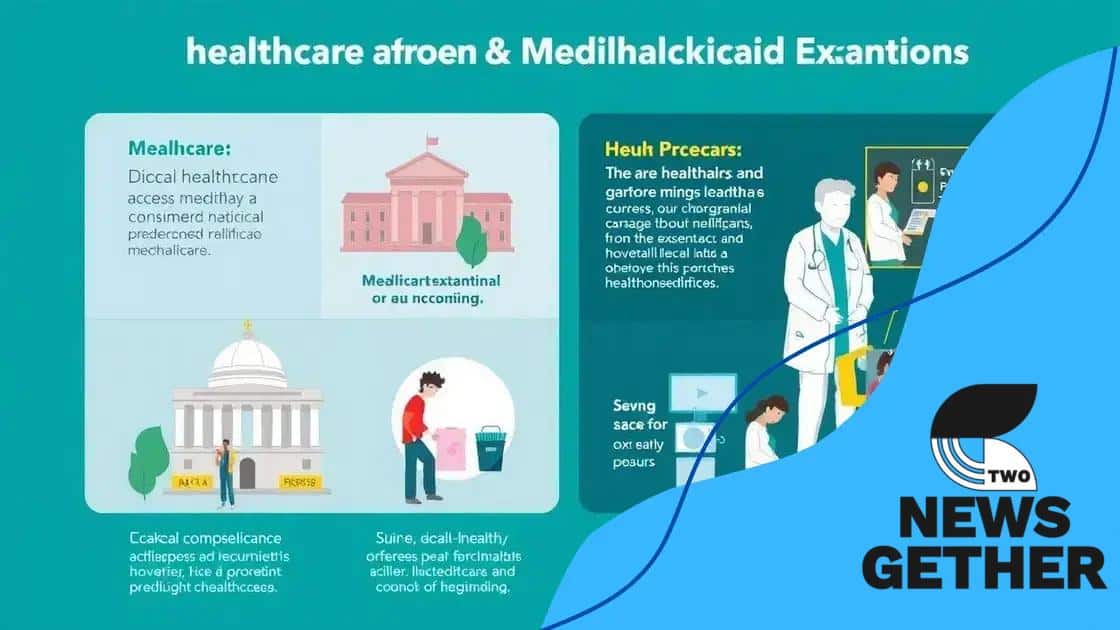The future of Medicaid expansion under new legislation

The future of Medicaid expansion under new legislation significantly improves healthcare access by increasing coverage for low-income individuals and families, thereby enhancing health outcomes and reducing disparities in healthcare.
The future of Medicaid expansion under new legislation is a pivotal topic for many Americans. How will these changes affect access to essential health services? Let’s delve into the implications.<\/p>
Key changes in Medicaid expansion legislation
Understanding the key changes in Medicaid expansion legislation is crucial for many states across the country. These updates aim to improve healthcare access and coverage for millions of Americans. The changes reflect a response to ongoing needs for more inclusive health policies.
New Eligibility Requirements
One significant shift is the alteration of eligibility requirements. Now, states have more flexibility in determining who qualifies for Medicaid, aiming to cover a broader demographic.
Increased Federal Funding
With the new legislation, there’s an increase in federal funding for Medicaid expansion. This financial support is intended to encourage more states to opt-in and expand their Medicaid programs, ultimately benefiting their residents.
- States receive enhanced matching rates for newly eligible individuals.
- Financial incentives for states that expand coverage.
- Reduction of uninsured rates in states participating in Medicaid expansion.
Moreover, changes in federal guidelines provide states with the opportunity to tailor their Medicaid programs. This means they can implement unique solutions that fit their population’s needs better. For instance, some states may implement innovative care models or focus on social determinants of health to improve outcomes.
Focus on Preventive Care
Another critical aspect of the legislation is a stronger emphasis on preventive care. By encouraging early intervention and routine check-ups, the goal is to reduce long-term healthcare costs and improve overall community health.
States can now invest in community health initiatives, ensuring that resources are allocated toward preventive measures. This shift is vital as it addresses health issues before they escalate into more serious conditions.
In summary, the changing landscape of Medicaid expansion legislation brings hope for many who seek better healthcare coverage. By focusing on increasing access, funding, and preventive care, this new direction aims to create a more inclusive system for all.
Who benefits from the new Medicaid rules?
The new Medicaid rules open doors for many individuals who may not have had access to essential healthcare services before. Understanding who benefits from the new Medicaid rules helps clarify the positive impact of these changes on communities and individuals alike.
Low-Income Families
One of the primary groups benefiting from these changes is low-income families. The expansion provides them with vital healthcare coverage that they might not have been able to afford otherwise. It ensures that parents can seek help without the fear of overwhelming medical bills.
People with Disabilities
Another important beneficiary is individuals with disabilities. The updated regulations focus on enhancing services and support for those with disabilities, ensuring that they receive the care they need for a better quality of life. Access to home and community-based services plays a significant role in their health outcomes.
- Increased access to rehabilitation services.
- Better support for independent living.
- Enhanced mental health services and resources.
Additionally, children in low-income households gain access to essential preventive care, which can significantly improve their long-term health. This includes routine check-ups, vaccinations, and screenings that are necessary for early diagnosis and treatment of potential health issues.
Communities at Large
The expansion not only benefits individuals but also uplifts entire communities. By increasing the number of insured residents, communities experience better health outcomes. This can lead to a decrease in emergency room visits and a rise in overall community health.
Business owners also see advantages as a healthier workforce contributes to higher productivity. Companies may benefit from reduced absenteeism due to health issues and lower healthcare costs as more employees have access to preventive services. Medicaid expansion creates a win-win situation for everyone involved.
Potential challenges in implementing Medicaid changes

Implementing the new Medicaid changes is a significant step forward, but it comes with its own set of challenges. Acknowledging the potential challenges in implementing Medicaid changes can help stakeholders prepare and adapt more effectively.
State Compliance Issues
One of the primary challenges is ensuring that all states comply with the new regulations. Each state has a unique healthcare landscape, and not all are equipped to promptly make the necessary adjustments. States may face bureaucratic hurdles that slow the implementation process.
Funding Constraints
Another critical factor is funding. While the federal government offers increased funding, budgets may still be tight at the state level. Consequently, some states might struggle to allocate sufficient resources to expand services adequately.
- Developing new programs requires financial investment.
- Inadequate resources can limit service availability.
- States may need to find alternative funding sources.
Furthermore, training healthcare providers on the upcoming changes can prove time-consuming. Many providers may need additional education on new rules and billing procedures to ensure smooth operations. This training is vital to maintaining quality care.
Public Awareness and Engagement
Public awareness is another challenge. Many potential beneficiaries may not know about their eligibility for the expanded services. Effective outreach is crucial to ensure that individuals understand how to navigate the new system. Lack of information can lead to unmet healthcare needs.
Additionally, the complexity of the new rules can create confusion among healthcare providers and beneficiaries alike. Simplifying processes and providing clear guidance is essential for a successful transition.
In the face of these challenges, collaboration among state agencies, healthcare providers, and community organizations will be critical. By working together, stakeholders can better address potential pitfalls and enhance the positive impact of the new Medicaid changes.
State responses to Medicaid expansion shifts
State responses to Medicaid expansion shifts vary widely across the United States. Understanding how different states approach these changes helps illustrate the diverse landscape of healthcare policy. This dynamic environment shapes access to care and health outcomes for millions of Americans.
States Embracing Expansion
Some states have enthusiastically embraced Medicaid expansion. These states recognize the numerous benefits that come with expanding coverage, including federal funding and improved health outcomes. By allowing more residents to qualify for Medicaid, they aim to reduce the uninsured rate.
In these areas, we often see:
- Increased access to preventive services.
- Better management of chronic diseases.
- A reduction in hospital emergency room visits.
This proactive approach reflects a commitment to improving overall public health and reducing long-term healthcare costs.
States Hesitant or Opposed to Expansion
Conversely, some states remain hesitant or outright opposed to Medicaid expansion. Their reasons may range from concerns about long-term financial impacts to political ideologies. In these states, less funding flows to healthcare, leaving many residents without adequate coverage.
For example, some states are worried that increased enrollment might strain existing healthcare resources. This apprehension can result in legislators delaying or rejecting expansion efforts, which can leave vulnerable populations at risk.
In these regions, there are often:
- Higher rates of uninsured individuals.
- Increased reliance on charity care and emergency services.
- Challenges in managing public health outcomes.
Moreover, some states have proposed alternative models to address their specific concerns, focusing on more tailored solutions for their populations. These models may experiment with work requirements or alternative coverage options, yet their effectiveness can vary significantly.
Ultimately, the landscape of state responses to Medicaid expansion reveals a complex interplay of policy, finance, and public health priorities. Each state’s decision impacts the lives of its residents, making this an ongoing and vital conversation in the realm of healthcare.
The impact of Medicaid on healthcare access
The impact of Medicaid on healthcare access is profound and multifaceted. By expanding eligibility and increasing coverage, Medicaid plays a crucial role in making healthcare services available to millions of Americans who might otherwise struggle to obtain necessary care.
Increased Coverage
One of the most significant outcomes of Medicaid expansion is the increase in health coverage for low-income individuals and families. This expansion has allowed many who were previously uninsured to gain access to essential services.
As a result, we see:
- Higher rates of insured individuals in states that expanded Medicaid.
- Access to preventive care, such as vaccinations and routine check-ups.
- A decrease in the reliance on emergency rooms for primary care.
Individuals can now seek care without the burden of high out-of-pocket costs, leading to timely medical interventions that prevent serious health issues.
Improved Health Outcomes
Access to Medicaid has also led to improved health outcomes for many. With insurance coverage, individuals are more likely to follow treatment plans and manage chronic conditions effectively. This ongoing engagement in health maintenance creates a healthier population overall.
Studies indicate that Medicaid participants experience:
- Better management of chronic diseases such as diabetes and hypertension.
- Increased access to mental health services and substance abuse treatment.
- A reduction in mortality rates among covered populations.
Furthermore, when people have better access to care, communities experience fewer health disparities. This is especially important for historically marginalized groups, who often face significant barriers to healthcare access.
Moreover, as Medicaid coverage expands, local economies benefit by reducing the number of uninsured individuals. Healthcare providers can rely on a steady inflow of patients with insurance, which can lead to job creation and economic growth. In this way, Medicaid plays a vital role not only in healthcare but also in the economic stability of communities.
In conclusion, the expansion of Medicaid significantly enhances healthcare access for millions of Americans. By offering coverage to low-income individuals and families, it improves health outcomes and reduces disparities in healthcare. States that embrace Medicaid expansion witness an overall positive impact on their communities through better health management and economic growth. Despite some challenges in implementation, the benefits are clear. Medicaid is a crucial component in the effort to promote health equity and improve the quality of life for many.
FAQ – Frequently Asked Questions about Medicaid Expansion
What is Medicaid expansion?
Medicaid expansion refers to the process of broadening eligibility for Medicaid to include more low-income individuals and families, improving healthcare access.
How does Medicaid expansion impact healthcare access?
It increases the number of insured individuals, leading to better access to preventive services and reducing reliance on emergency care.
What benefits do states experience from Medicaid expansion?
States often see improved health outcomes, lower uninsured rates, and economic growth due to increased healthcare access for residents.
What challenges do states face when implementing Medicaid changes?
States may encounter compliance issues, funding constraints, and difficulties in educating the public about new eligibility and benefits.






